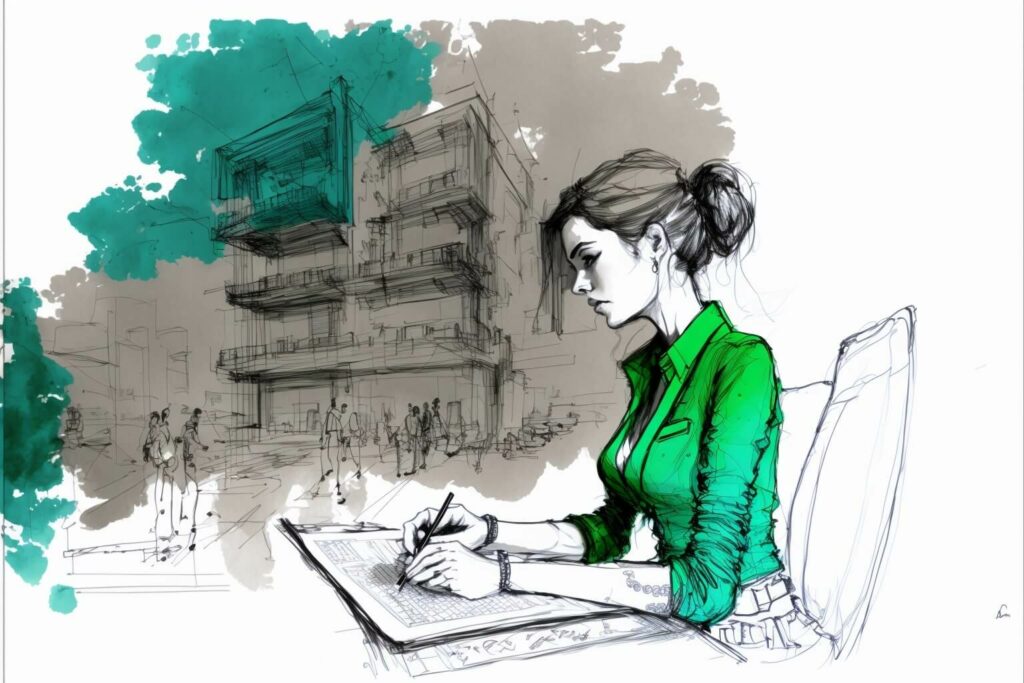





A 2-day immersion into the future of sustainable construction
As we begin a new year, many of us may be thinking about ways to make it more meaningful and fulfilling. One way to do this is by developing specific skills to help us positively impact the world and find a sense of purpose in our work.
As architects, we can explore several vital topics to help us develop these skills and create a positive mindset.
This article will examine these topics and how they can help us create more sustainable, inclusive, and meaningful designs. So, if you want to make this year more expressive, read on to learn more.


Skills for Architects #1: Sustainable Design
Sustainable design is a design approach that focuses on minimizing the negative environmental impact of buildings and communities while maximizing their benefits.
This can involve using materials and technologies that are energy-efficient, resource-efficient, and environmentally friendly, as well as designing buildings and communities that are adaptable and resilient to changing conditions.
There are many different aspects of sustainable design that architects may consider, such as:
- Energy efficiency: This can involve designing buildings that use less energy, such as through insulation, energy-efficient windows and doors, and high-efficiency heating and cooling systems.
- Water efficiency: Architects can design buildings that use water efficiently, such as low-flow fixtures and greywater systems.
- Materials and resources: Architects can choose materials that are sustainable and have a low environmental impact, such as locally sourced materials, recycled materials, and durable materials that will last for a long time.
- Site selection and development: Architects can consider the impact of a building on its surroundings, such as by preserving natural habitats, protecting waterways, and minimizing the amount of developed land.
By focusing on sustainable design, architects can help create buildings and communities that are healthier, more efficient, and more resilient and that have a lower impact on the environment.
Skills for Architects #2: Inclusive Design
Inclusive design is a design approach that considers the needs and abilities of all users, including those with disabilities. It aims to create spaces that are accessible and usable by everyone, regardless of age, ability, or background.
There are many different aspects of inclusive design that architects may consider, such as:
- Physical accessibility: This can involve designing buildings and spaces accessible to people with physical disabilities, such as wheelchairs or mobility aids. This can include creating ramps, elevators, and other features that make it easier for people to move around the building.
- Visual accessibility: Architects can design buildings and spaces accessible to people with visual impairments, such as those who are blind or have low vision. This can involve creating braille signage, contrasting different surfaces, and using lighting to highlight important features.
- Auditory accessibility: Architects can design buildings and spaces accessible to people with hearing impairments, such as those who are deaf or hard of hearing. This can involve creating assistive listening systems, using visual indicators for alarms, and providing clear sightlines for lip reading.
- Cognitive accessibility: Architects can design buildings and spaces accessible to people with mental disabilities, such as those with developmental delays or learning disabilities. This can involve creating clear and concise signage, using simple and consistent layouts, and providing plenty of wayfinding aids.
By designing for inclusion, architects can help create buildings and spaces that are welcoming and usable by everyone and that promote equality and accessibility for all.


Skills for Architects #3: Community Engagement
Community engagement is the process of involving members of a community in the planning and design of buildings and spaces that will impact them. It consists of seeking input and feedback from the district and working collaboratively to create solutions that meet their needs and preferences.
There are many benefits to involving the community in the design process, including the following:
- Building trust and relationships: By engaging with the community, architects can build trust and establish relationships with the people using the design spaces. This can help foster a sense of ownership and pride in the community and can also help ensure that the final design is more responsive to the needs and preferences of the community.
- Gathering valuable insights: Engaging with the community can provide architects with valuable insights and perspectives that can inform their designs. This can include information about local customs, traditions, and values, as well as practical considerations such as the types of activities and events in the community.
- Encouraging collaboration and teamwork: Community engagement can foster collaboration and teamwork among the various stakeholders involved in the design process, including architects, engineers, contractors, and community leaders. This can help create a sense of shared ownership and commitment to the final design.
There are many different ways that architects can engage with the community, such as through public meetings, surveys, focus groups, and other forms of outreach.
By involving the community in the design process, architects can create buildings and spaces that are more responsive to the needs and preferences of the people who will use them, contributing to the community’s overall health and well-being.
Skills for Architects #4: Social and Cultural Considerations
Social and cultural considerations are important aspects of design that involve taking into account the social and cultural context of the community where a building or space will be located.
This can include things like local customs, traditions, and values, as well as the unique history and character of the community.
By considering social and cultural considerations in their designs, architects can create buildings and spaces more responsive to the needs and preferences of the people who will use them, reflecting and celebrating the local culture.
There are many different ways that architects can incorporate social and cultural considerations into their designs, such as:
- Incorporating local materials: Architects can use materials native to the region or solidly connected to the local culture, such as local stone or wood. This can help create a sense of place and contribute to the local economy.
- Reflecting local architecture: Architects can draw inspiration from regional architectural styles and traditions, such as using traditional building techniques or incorporating conventional design elements. This can help create a sense of continuity and respect for the local culture.
- Incorporating cultural symbols and motifs: Architects can incorporate cultural symbols and motifs into their designs, such as incorporating traditional patterns or designs into building facades or interiors. This can help celebrate the local culture and create a sense of identity for the community.
- Providing spaces for community gatherings: Architects can design buildings and spaces that offer opportunities for community gatherings, such as courtyards or plazas, to encourage social interaction and build a sense of community.
By considering social and cultural considerations in their designs, architects can create buildings and spaces that are more authentic, meaningful, and responsive to the needs and preferences of the community.










A 2-day immersion into the future of sustainable construction


Skills for Architects #5: Innovative Technologies
Innovative technologies are new and advanced technologies that can improve the efficiency, performance, and sustainability of buildings and communities. Architects can explore the use of innovative technologies in their designs to create buildings and spaces that are more efficient, adaptable, and resilient.
There are many different innovative technologies that architects may consider, such as:
- Energy-efficient systems: Architects can use energy-efficient technologies, such as solar panels, geothermal systems, and high-efficiency heating and cooling systems, to reduce the energy consumption of buildings and communities.
- Innovative technologies: Architects can explore intelligent technologies, such as building management systems, sensor networks, and automation systems, to improve the performance and efficiency of buildings.
- Sustainable materials: Architects can consider using sustainable materials, such as recycled materials, low-impact materials, and biomimetic materials, to reduce the environmental impact of buildings and communities.
- Adaptive systems: Architects can design buildings and communities that are adaptable and resilient to changing conditions, such as through the use of green infrastructure, adaptive building envelopes, and modular construction techniques.
By exploring the use of innovative technologies in their designs, architects can create buildings and spaces that are more efficient, adaptable, and sustainable and that have a lower impact on the environment.
Skills for Architects #6: Collaboration and Teamwork
Collaboration and teamwork are essential skills for architects to cultivate to create effective design solutions. Collaboration involves working with other professionals and stakeholders, such as engineers, contractors, and community leaders, to achieve a common goal.
There are many benefits to collaboration and teamwork in the design process, including:
- Sharing knowledge and expertise: By collaborating with other professionals, architects can learn from their expertise and insights and share their knowledge and skills.
- Improving the design quality: Collaboration can help ensure that all aspects of the invention are considered and that the final design is more cohesive and effective.
- Enhancing efficiency: Collaboration can help streamline the design process and reduce the time and resources required to complete a project.
- Building relationships: Collaboration can help build relationships and establish trust among the various stakeholders involved in the design process, which can benefit future projects.
To cultivate collaboration and teamwork skills, architects can:
- Communicate effectively: Good communication is essential for successful collaboration. Architects can develop their communication skills by being clear and concise, actively listening, and seeking feedback from others.
- Be open to new ideas: Collaboration involves being open to the ideas and perspectives of others. Architects can work to cultivate an open and inclusive mindset and be willing to consider different approaches and solutions.
- Manage conflicts: Conflicts are a normal part of any collaborative process. Architects can work to develop their conflict resolution skills, such as by listening to the concerns of others, seeking compromise, and being willing to find creative solutions.
By cultivating collaboration and teamwork skills, architects can work more effectively with other professionals and stakeholders to create design solutions that meet the needs and preferences of the community.


Skills for Architects #7: Professional Development
Professional development is the ongoing process of learning and growing in one’s profession. It involves seeking opportunities to learn new skills, stay up-to-date on the latest trends and best practices, and improve workplace performance.
There are many benefits to professional development for architects, including:
- Improved skills and knowledge: Professional development can help architects stay up-to-date on the latest trends and best practices in the field and can also help them develop new skills and knowledge that can improve their performance.
- Enhanced career opportunities: Engaging in professional development can help architects stay competitive and open up new career opportunities.
- Personal growth: Professional development can be valuable for personal growth and self-improvement. It can help architects set and achieve professional goals and can also help them build confidence and self-esteem.
There are many different ways that architects can engage in professional development, such as:
- Continuing education courses: Architects can take continuing education courses to learn new skills or stay up-to-date on the latest trends and best practices in their field.
- Professional associations: Architects can join professional associations, such as the American Institute of Architects (AIA), which offer professional development opportunities, such as conferences, workshops, and online courses.
- On-the-job training: Architects can engage in on-the-job training by working with more experienced colleagues or taking on new responsibilities to learn new skills and gain practical experience.
- Self-study: Architects can engage in self-study, such as by reading industry-related books, articles, and blogs or by participating in online forums and discussion groups.
By engaging in professional development, architects can stay up-to-date on the latest trends and best practices in their field and continue to grow and improve as professionals.










A 2-day immersion into the future of sustainable construction


Skills for Architects #8: Creativity and Innovation
Creativity and innovation are essential skills for architects to cultivate to come up with unique and practical design solutions.
Creativity involves using imagination and originality to generate new ideas and approaches, while innovation involves taking those ideas and turning them into practical solutions.
There are many benefits to cultivating creativity and innovation in architecture, including the following:
- Improved problem-solving: Creativity and innovation can help architects think outside the box and create creative solutions to complex problems.
- Enhanced design quality: Creativity and innovation can help architects create more unique and effective designs that stand out and meet the needs and preferences of the community.
- Increased competitiveness: Creativity and innovation can help architects stay competitive by creating unique and innovative design solutions.
There are many different ways that architects can cultivate creativity and innovation, such as:
- Brainstorming: Architects can engage in brainstorming sessions, either individually or with a team, to generate new ideas and approaches.
- Seeking inspiration: Architects can look for inspiration from various sources, such as other design disciplines, nature, or local culture, to spark their creativity.
- Collaborating with others: Collaborating with other professionals and stakeholders can help stimulate creativity and generate new ideas.
- Experimenting and prototyping: Architects can experiment with different materials and techniques and create prototypes to test their ideas and see how they might work.
By cultivating creativity and innovation, architects can come up with unique and practical design solutions that meet the needs and preferences of the community.
Skills for Architects #9: Personal Growth
Personal growth and well-being are essential for architects to prioritize to maintain a positive mindset and stay motivated to impact their work positively.
Personal development involves setting and working towards personal goals, including learning new skills, developing new habits, or improving personal relationships. Well-being consists in taking care of one’s physical, mental, and emotional health.
There are many benefits to prioritizing personal growth and well-being, including:
- Improved productivity and performance: By taking care of their well-being, architects can feel more energized and focused, improving their productivity and performance.
- Greater resilience and adaptability: Prioritizing personal growth and well-being can help architects become more resilient and adaptable, which can be valuable in facing challenges and changes.
- Enhanced creativity and innovation: Taking care of one’s well-being can help stimulate creativity and innovation, allowing architects to be more present and focused on their work.
There are many different ways that architects can prioritize personal growth and well-being, such as:
- Setting goals: Architects can set specific, achievable goals and work towards them consistently. This can help them feel a sense of accomplishment and progress, boosting their confidence and motivation.
- Practicing self-care: Architects can prioritize self-care by getting enough sleep, eating well, exercising regularly, and finding time to relax and recharge.
- Seeking support: If architects are struggling with their personal growth or well-being, they can seek support from a therapist, trusted friend, or family member.
By prioritizing personal growth and well-being, architects can maintain a positive mindset and stay motivated to impact their work positively.
Conclusion
As we’ve seen, there are many different skills that architects can develop to help create a positive mindset and make a positive impact in the world.
By focusing on topics such as sustainable design, inclusive design, community engagement, social and cultural considerations, innovative technologies, collaboration and teamwork, professional development, creativity and innovation, and personal growth and well-being, we can find more meaning and purpose in our work and create spaces that are more responsive to the needs and preferences of the community.
So, as you look ahead to the new year, consider what skills you would like to develop and how you can implement them.
Whether it’s through continuing education courses, working with communities, seeking out new technologies, or focusing on your personal growth and well-being, there are many ways you can make a positive impact in your work as an architect.
So, take the time to reflect on what matters most and start putting things into action today.
If you want to read this article in Portuguese, click here.










A 2-day immersion into the future of sustainable construction

